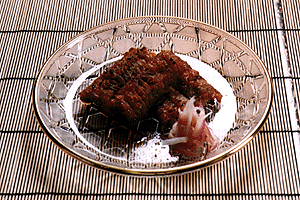| Hamo (pike eel) is a familiar fish for people of Kansai, but not so common for people living in the Tokyo region and northwards. It is a kind of sea fish similar to eel and conger eel. It lives in warm seas and is caught in Japanese coastal waters between the Kii Peninsula and Amakusa in Kumamoto, Kyushu. The name hamo comes from hamu, an archaic word meaning "to eat", because the fish uses its sharp teeth to eat almost anything from squillas, shrimps and crabs to small fish. It is a seasonal summer delicacy in Kansai, and an indispensable item for the Tenjin Festival in Osaka and the Gion Festival in Kyoto. Two types of hamo, called mabamo and suzuhamo (or toheihamo), are available on the market. The two look very similar, but suzuhamo has a bigger, craggier head, and its lateral line is rough to the touch. It is about half the price of mabamo, because its bones are harder and its meat less firm, so be careful when you buy it. All kinds of fish are raised in fish farms these days, but not hamo (although research is currently under way). As you can imagine from the origin of its name, hamo is a strong fish. Even in the days before modern transportation, they could survive the journey all the way to Kyoto from distant fishing ports. That is why it is a frequent ingredient in Kyoto cuisine. A hamo could grow to lengths of up to two meters. But as a cooking ingredient, hamo that are about one meter long and weigh 400-500 g are the best. I once dressed a huge hamo weighing 7 kg: it was a huge hassle. In the end, I just ground it up to make fish paste. |
